Rotterdam is a must-visit place in the Netherlands because of its modern architecture and youthful vibe. With just 48 hours to take it all in, planning your visit can be as crucial as the journey itself. Whether you’re a first-time visitor or making a return trip, optimizing your itinerary to get an authentic taste of this city’s unique offerings is critical. In this post, we’ll share what you need to see in Rotterdam in 2 days. Below, I’ve included a list of must-see attractions and tips for the perfect 48-hour itinerary in Rotterdam.
Rotterdam is a city in the Netherlands located in the western part of the country. Specifically, it is in the province of South Holland, lying east of The Hague and south of Amsterdam. It is approximately 19 miles (30 kilometers) from the coast of the North Sea.
The origin of Rotterdam dates back to 1270 with the construction of a dam on the Rotte River. Over time, this settlement grew into a small fishing village, and by the 1340s, it obtained city rights. However, it wasn’t until the 19th century that Rotterdam underwent significant expansion due to developments in shipping and trade. One pivotal year was 1872, when the Nieuwe Waterweg (New Waterway), a ship canal, opened, enhancing access to the North Sea and establishing Rotterdam as a significant port city.
What sets Rotterdam apart from other cities is its modern architectural landscape. This is mainly because on May 14, 1940, during World War II, aerial bombers destroyed large parts of the city. Hence, reconstruction efforts started to rebuild the city, resulting in an entirely new cityscape dominated by innovative building designs.
Essential Tips for the Perfect 2 Days in Rotterdam
1. When is the best time to visit Rotterdam?
Rotterdam has a temperate maritime climate, with mild summers and cool winters. However, you can expect precipitation evenly throughout the year. The warmest months are July and August, with an average temperature of approximately 62 to 68ºF (17 to 20ºC). Hence, this is the best time to visit Rotterdam for sightseeing and outdoor activities.
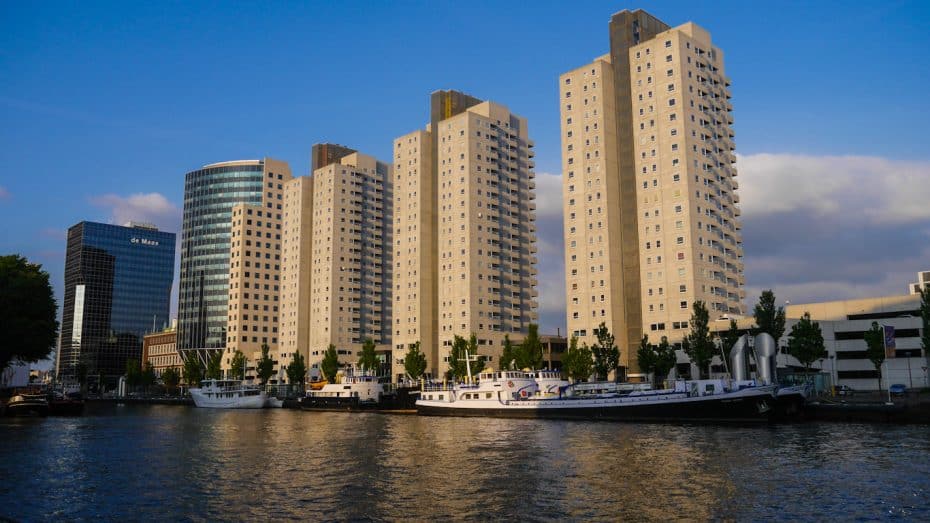
In the winter, temperatures average between 35 and 42ºF (2 and 6ºC). Snowfall is possible but not common during this season.
From March to May, spring gradually increases temperatures, with daily averages ranging from 42 to 55ºF (6 to 13ºC) by May. This season provides an opportunity to witness the blooming of flowers in parks and public gardens. So, you could also travel to Rotterdam in the spring if you love parks and gardens (and who doesn’t?)
Autumn arrives in September and brings cooler temperatures and an increase in rainfall. Temperature averages drop from about 57ºF (14ºC) in September to around 48ºF (9ºC) in November.
2. How to get to and around Rotterdam
Rotterdam has several transportation options to visit or commute to the city. Here’s how you can get to Rotterdam:
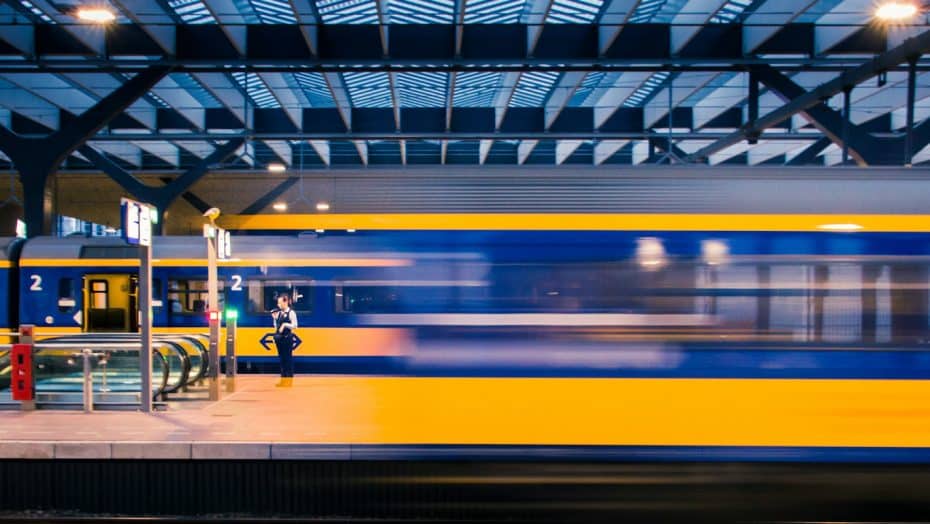
- Trains. Intercity and high-speed train services connect Rotterdam with other Netherlands and European cities. The country’s rail network, operated by Nederlandse Spoorwegen (NS), offers direct connections from cities like Amsterdam, The Hague, and Utrecht. You can also board high-speed trains from Paris, London, and Brussels via the Thalys and Eurostar services. The high-speed train from Amsterdam Central to Rotterdam Central typically takes 40 minutes.
- Buses. FlixBus and Eurolines have long-distance bus services connecting Rotterdam with cities in the Netherlands and other European destinations. These buses often stop at Rotterdam Centraal or Rotterdam’s Zuidplein transport hub.
- Flights. Rotterdam The Hague Airport serves both domestic and international flights. However, due to its more extensive range of flights, many passengers arrive in the Netherlands through Amsterdam Airport Schiphol. After landing at Schiphol, you can transfer to Rotterdam by direct train from Schiphol Airport station.
- Ferries. Different ferry services operate between cities in the United Kingdom and the port of Rotterdam. Overnight ferries run from Hull and Newcastle upon Tyne in England, offering an alternative for those traveling with a car.
The public transport system around Rotterdam includes buses, trams, ferries, and a metro operated by RET (Rotterdamsche Elektrische Tram). Here’s a short overview of each transport method you can use to travel through Rotterdam’s areas:
- Trams. The first electric tram in Rotterdam started in 1905. Today, the tram network has nine lines covering approximately 57 miles (93km).
- Metro. The city’s metro system began operations on February 9, 1968, making it the first metro system in the Netherlands. It consists of five lines that serve 62 stations, facilitating travel across the city and beyond, including connections to The Hague with RandstadRail.
- Ferries. Water-based vehicles are also part of Rotterdam’s public transportation system. The waterbus service operates routes on the Meuse River and covers areas like Dordrecht and Kinderdijk.
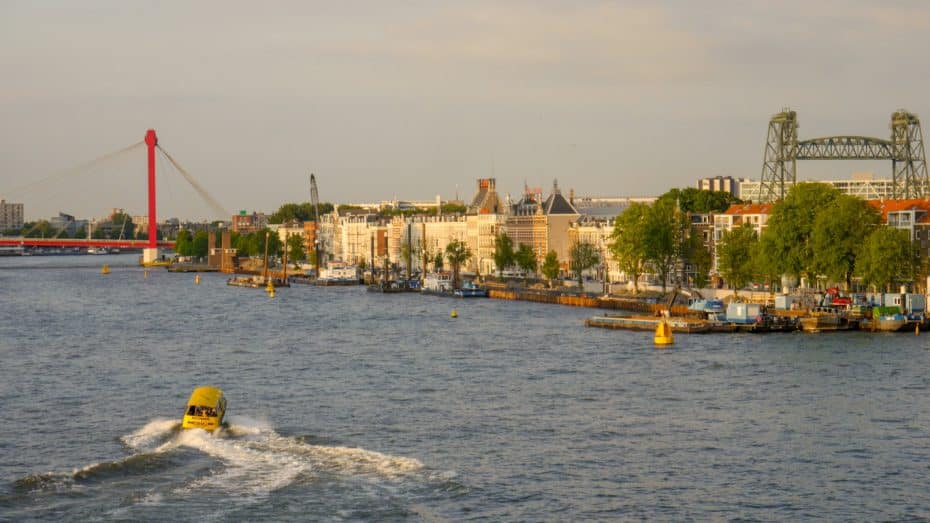
- Cycling. Bicycles are essential for everyday transport in the Netherlands. So, Rotterdam promotes cycling as an efficient and sustainable way to travel. Cyclists benefit from an extensive network of bike paths throughout the city. Bike parking is also taken seriously, with secure bicycle parking facilities. Public bike-sharing systems are available for those who do not own a bike. Hence, cycling is a must for things to do in 2 days in Rotterdam. However, be aware that cyclists in the city don’t have any patience for amateurs, so you may want to avoid riding with them if you are a newbie (speaking from experience here).
3. Accommodation and best area to stay in Rotterdam
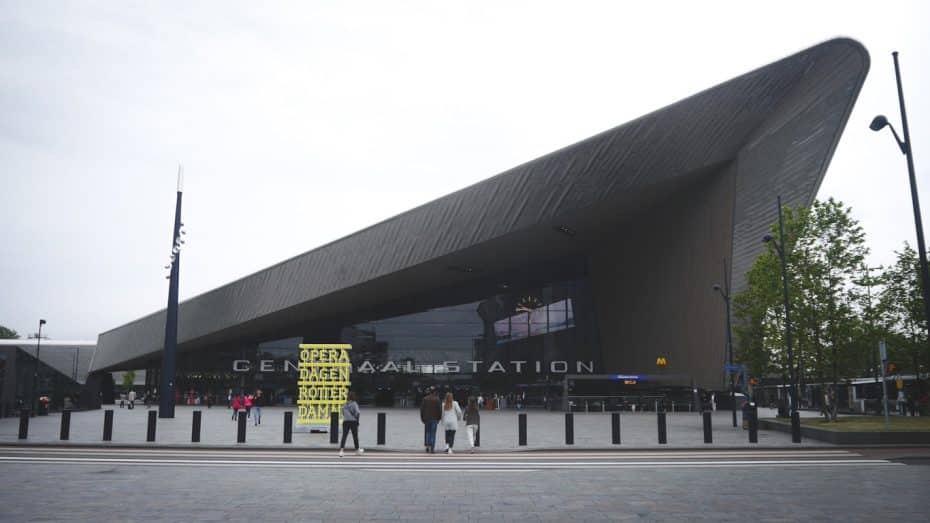
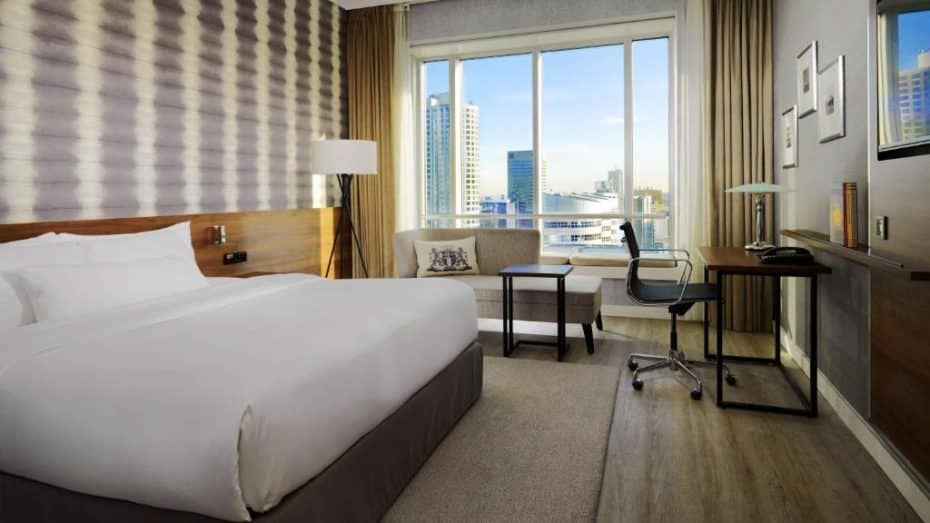
The Centrum district occupies a core position in the city and is the best area to stay in Rotterdam, surrounded by the neighborhoods of Delfshaven, Kralingen-Crooswijk, and Noord. Dating back to the 13th century, the Centrum has played a central role in Rotterdam’s development. After the devastation during World War II led to extensive rebuilding projects, this area became a focus point for the new Rotterdam. Thus, the Centrum stands today as a representation of modern architectural advancements and careful urban planning that honors its origins.
Staying in this area will keep you close to Rotterdam’s central train station. As such, you can easily plan a train route through the Netherlands while staying in this district. Likewise, this district also hosts most of the city’s main attractions.
Regarding accommodations in the Centrum, you can choose between cheap hostels, high-end apartments, and some of the best-rated hotels in Rotterdam. Furthermore, these accommodations are often located near public transport stations, facilitating travel throughout the city.
Read our accommodation guide for more about the best areas to stay in Rotterdam.
4. Activities and guided tours in Rotterdam
During a short stay of 48 hours in Rotterdam, the second-largest city in the Netherlands, it is practical to engage in organized activities to explore significant landmarks and cultural highlights efficiently.
Rotterdam’s tourist information website is a good source for activities in the city. This site is available in English and Dutch and includes information on tours with kids, activities for foodies, street art walks, and more. Moreover, some of these tours are free.
As with most big cities, a guided tour is the best way to get to know Rotterdam. These tours are handy if you only have a little time to explore the city and it’s your first time there.
Things to see in Rotterdam in 2 days: The perfect itinerary
1. Cube Houses
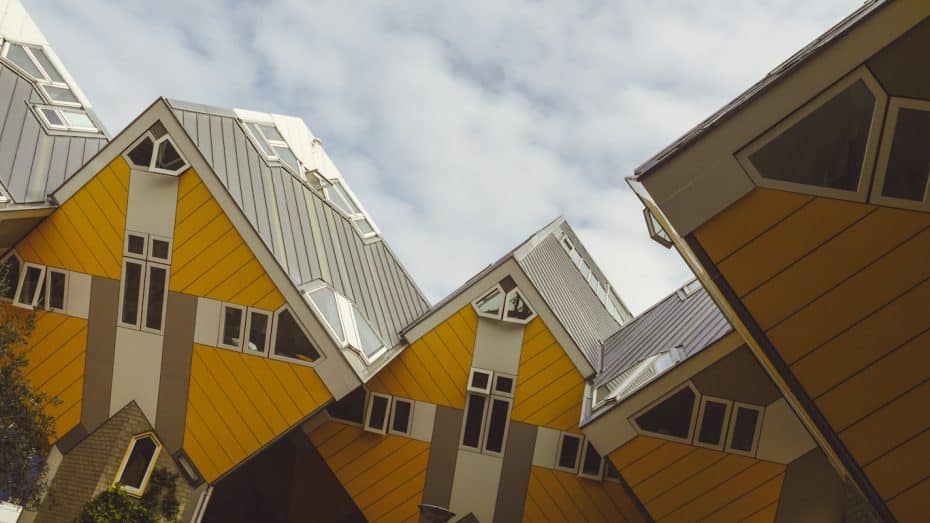
The Cube Houses (Kubuswoningen) in Rotterdam are innovative houses designed by architect Piet Blom. Conceived in 1977 and built between 1982 and 1984, these architectural oddities reflect Blom’s idea of creating “living as an urban roof”: high-density housing with sufficient space on the ground level. His design represents a village within a city, where each house represents a tree, and all the places together make up a forest.
The Cube Houses are on Overblaak Street, above the Blaak Subway Station. They consist of 38 small cubes and two so-called super-cubes, all attached. As a break from traditional housing, each cube is tilted at a 45-degree angle and rests upon a hexagon-shaped pylon. Their peculiar shape has made them an iconic example of innovative Dutch architecture.
The internal space of these houses has three levels. The ground floor contains the living area, and the second floor holds the bedrooms and bathroom. Meanwhile, the top floor, often called the “high room,” could serve as an additional living space. Due to their unconventional shape, interior decoration presents challenges since furniture must be custom-made to fit the inclined walls.
One cube, known as the “Show Cube” (Kijk-kubus), is open to the public. It gives an idea of what life inside these architectural curiosities might be like. This Show Cube functions as a museum dedicated to these houses. It is generally open daily from 11:00 AM to 5:00 PM, and the entrance price is typically around €3.00. Most walking tours of Rotterdam include a stop at the Cube Houses.
2. Markthal
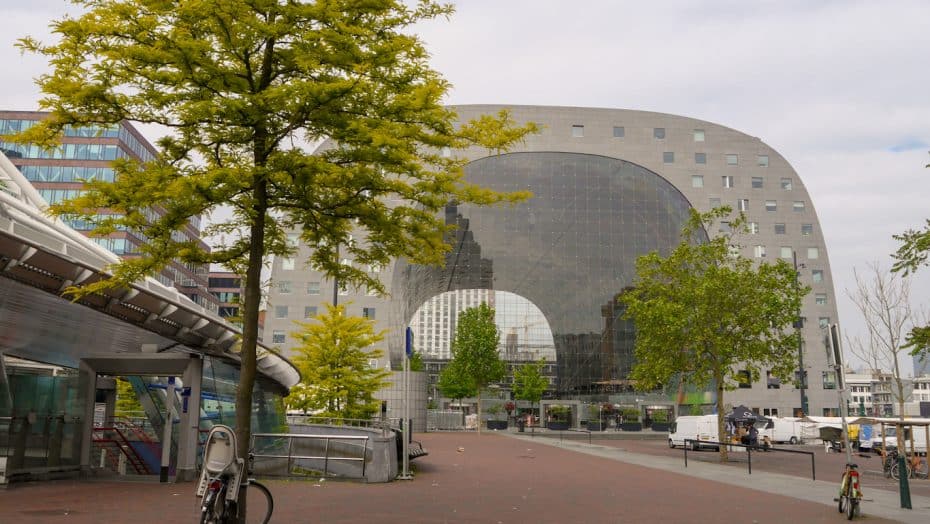
Of course, no 48 hours or weekend in Rotterdam would be complete without having breakfast in the Markthal.
The Markthal is a market that opened in 2014. This indoor market is notable for its large size and the fact that it also has residential space within its structure. Architecturally, it stands out with a horseshoe-like shape and an impressive interior artwork known as the “Horn of Plenty” by artists Arno Coenen and Iris Roskam.
Covering approximately 100,000 square feet, the Markthal hosts over 100 fresh produce sellers, food shops, and restaurants on two underground levels. The ground floor marketplace remains open six days a week, typically from 10:00 am to 8:00 pm Monday through Thursday and Saturday; on Fridays, it extends its hours until 9:00 pm and operates with shorter hours from 12:00 pm to 6:00 pm Sunday.
The Markthal serves multiple purposes beyond trading goods. It is also designed for residential use, with 228 apartments lining the walls. These apartments have windows that look down into the market.
3. Old Harbor (Oude Haven)
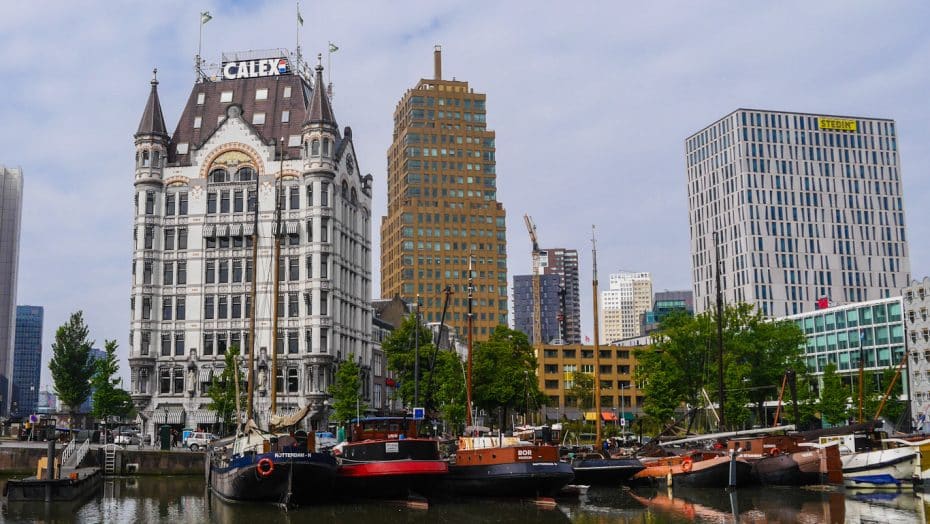
The Old Harbor, known as Oude Haven in Dutch, is an essential area in Rotterdam with a long history. This place dates back to the 14th century, around 1350, when it served as a port for ships. Over time, the harbor became surrounded by historic buildings and warehouses, many of which still stand today. In the 1890s, after the development of the modern Port of Rotterdam, the Old Harbor’s role in maritime trade diminished.
Today, Oude Haven stands out for its historical value and is part of Rotterdam’s Maritime District. Around the harbor, you can witness the contrast between old and modern architecture. The White House, built in 1898, is one of Europe’s first high-rise buildings and a remarkable sight in the area.
4. Maritime Museum
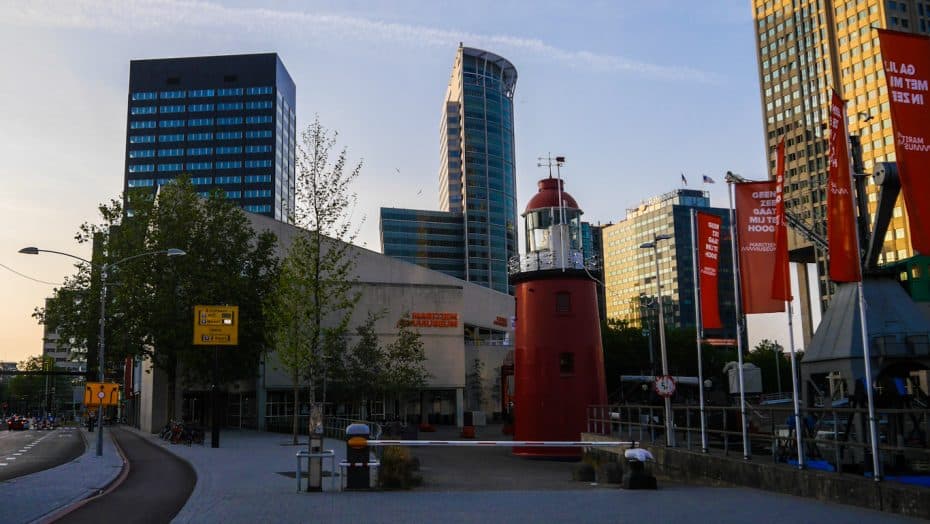
The Maritime Museum in Rotterdam is a museum dedicated to naval history. It is in the center of Rotterdam, near the Blaak district and the Oude Haven. The museum opened in 1874 and has been at its current site since 1986.
The museum’s collection includes over 850,000 objects related to maritime history. This extensive collection helps illuminate the naval history of the Netherlands, from the Dutch East India Company to modern shipping. The museum’s main building contains maps, ship models, paintings showcasing maritime events, navigation tools, and artifacts recovered from shipwrecks. Notable items within the museum include ship models from the Golden Age of Dutch naval power, maritime art, and objects related to the history of Rotterdam’s port.
The Maritime Museum is open Tuesday through Saturday from 10:00 a.m. to 5:00 p.m. and Sundays from 11:00 a.m. to 5:00 p.m. It is closed on Mondays. The entry price for adults is 17.50 euros. To skip lines at the ticket office, you can buy tickets for the Maritime Museum online.
For more information, visit the museum’s official website.
5. Witte de Withstraat
Witte de Withstraat is a street in the center of Rotterdam known for its cultural activities and dining options. It was named after Admiral Witte Corneliszoon de With, who was born in 1599 in Brielle and is part of the Cool district. Today, Witte de Withstraat serves as a crucial cultural axis in the city, housing numerous art galleries and museums, such as the Witte de With Center for Contemporary Art, which opened in 1990.
Regarding food, you will find several restaurants and cafés along Witte de Withstraat. The cuisines served include Dutch, Mediterranean, Asian, and others. Thus, you can’t miss having lunch in this part of the city during your 2 days in Rotterdam.
6. Boijmans Van Beuningen Museum
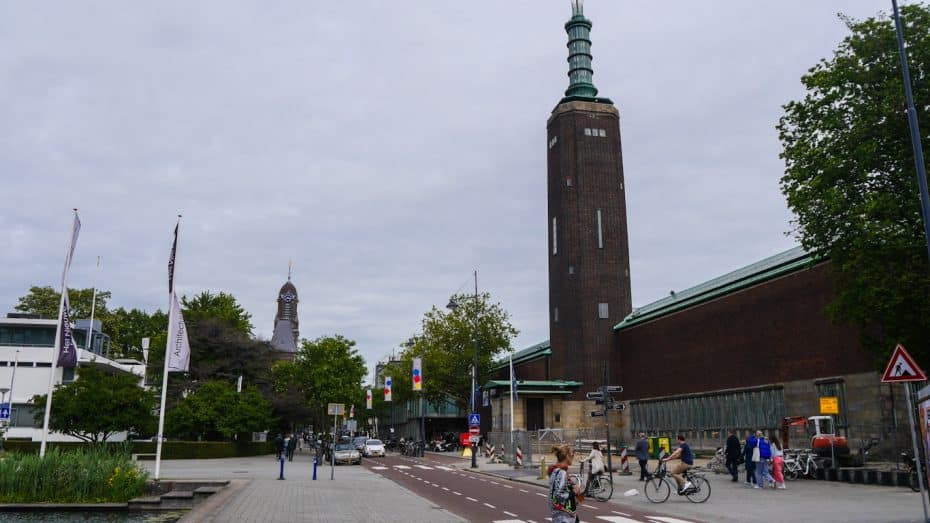
The Boijmans Van Beuningen Museum is an art museum established in 1849. Its name comes from two significant benefactors, Frans Jacob Otto Boijmans and Daniël George van Beuningen. The museum houses a collection of fine arts, decorative arts, and industrial design.
Upon entering the museum, you will encounter works from the Middle Ages to the 21st century. Among the pieces displayed are works by old masters such as Rembrandt, Van Gogh, and Bosch. Modern art by Salvador Dalí and René Magritte also forms part of the museum’s collection.
The museum operates from Tuesday to Sunday, with doors open from 11 am to 5 pm. The ticket price for an adult is 20 euros. Visit the museum’s website for more information.
7. Euromast
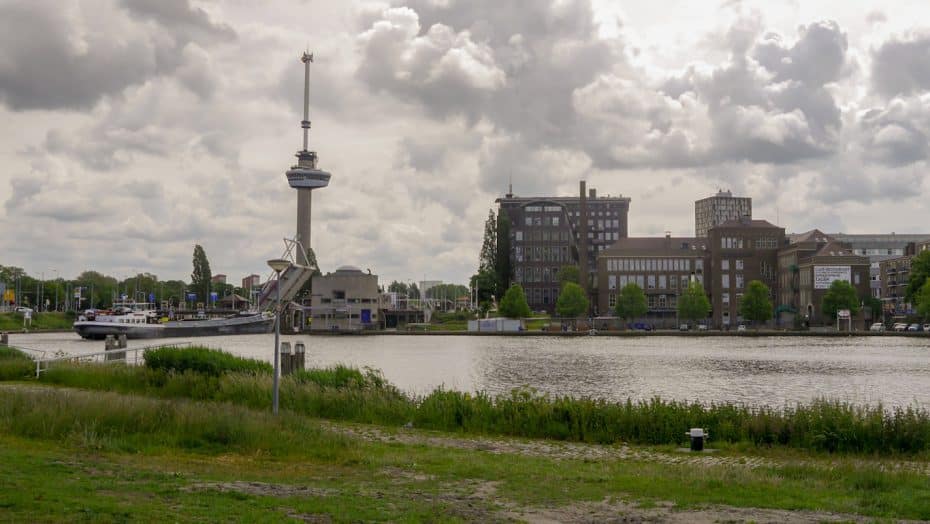
The Euromast observation tower, designed by Hugh Maaskant and built between 1958 and 1960, was specially created for the 1960 Floriade gardening exhibition and became a significant tourist attraction. It stands in the on the northern bank of the Nieuwe Maas river.
When visiting Rotterdam on a short two-day trip, consider dining at the Euromast’s restaurant. After all, the restaurant provides a unique opportunity to view the city from a height of 314 feet (96 meters). The tower’s total structure extends to 606 feet (185 meters) due to its space tower addition in 1970, which makes it an excellent viewpoint. You can see the city’s architecture and docklands; on clear days, views extend to The Hague’s skyline and beyond.
Reaching Euromast is straightforward, given its prominence. You can use public transport—buses and trams service the area—or enjoy a walk along the scenic Parkhaven. Regarding opening times, Euromast is open to visitors seven days a week, although hours may vary, typically from 9:30 AM to late evening. Dinner at the restaurant usually requires a booking, with times available from late afternoon until close.
You can get tickets to the Euromast online to skip the line. You can also make a reservation to the restaurant by clicking here.
8. Delfshaven
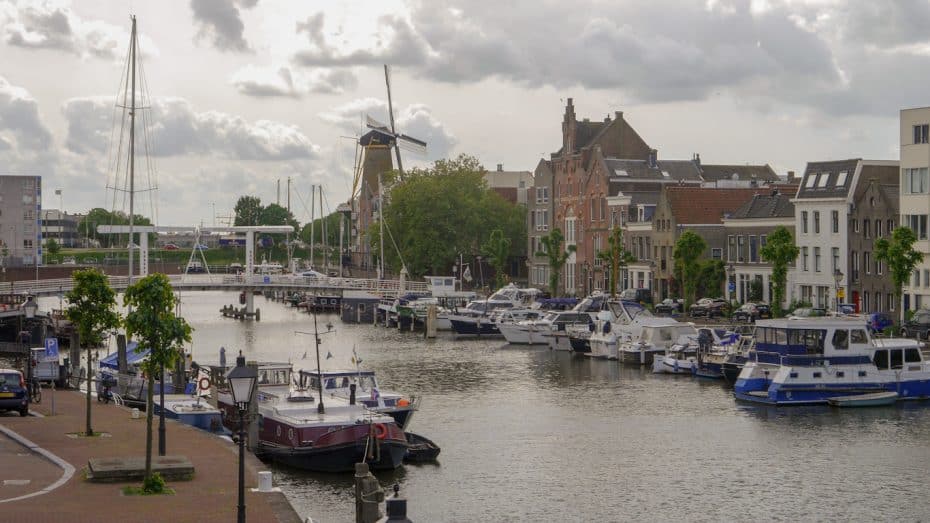
Delfshaven is a district in Rotterdam located in the west part of the city. Its history dates back to 1389 when it started as a seaport of the town of Delft, which did not have direct access to the sea. Delfshaven survived the Luftwaffe bombing of Rotterdam during World War II, which destroyed most of the city’s center. Thus, Delfshaven is one of the few areas in Rotterdam where you can still find historic buildings.
Today, Delfshaven offers a picturesque escape from the modern architecture in most of Rotterdam. Notable landmarks in Delfshaven include the Pilgrim Fathers Church (Oude of Pelgrimvaderskerk in Dutch), where pilgrims worshiped before departing for America in 1620. Furthermore, this historic area also houses museums, craft shops, and art studios.
Visiting Delfshaven provides an opportunity to experience ancient buildings such as the Distilleerketel, a historic distillery, and to walk along canals lined with old houses. Additionally, it is home to the municipal museum Het Dubbelde Palmboom, which showcases local history.
To reach Delfshaven from central Rotterdam, you can take tram line 4 or metro line A towards Marconiplein station.
9. Rotterdam Zoo

Rotterdam Zoo, also known as Diergaarde Blijdorp, is a notable attraction in the city. This zoo opened at its current location in 1940. Its history dates back to 1855, when two railway workers established the original collection. The zoo then moved to a new site due to railway expansion. It is one of Europe’s oldest zoos and stands out for its conservation efforts and wide variety of species.
The zoo is at Blijdorplaan 8, northwest of Rotterdam’s city center. Inside, you can explore different habitats, such as the Oceanium, which showcases marine life and includes a walkthrough sea tunnel. Likewise, you can see the historical Riviera Hall, initially part of the 1930s design by architect Sybold van Ravesteyn but repurposed as an elephant enclosure.
In terms of specific things to see, the zoo hosts Asian elephants, polar bears, red pandas, and gorillas, among other animals. The botanical garden within the zoo features old trees and plants from all over the world.
To reach Diergaarde Blijdorp, take tram line 4 from Rotterdam Central Station or bus lines 40 and 44. It is also within walking distance (about 15 minutes) from the station.
The zoo operates daily from 9:00 AM until dusk, with closing times varying seasonally. The last admission is typically an hour before closing. The entry fee for adults is 27 euros, and you can get your tickets online to avoid waiting. If you would like to know more about the zoo, you can visit its official website.
10. Het Park
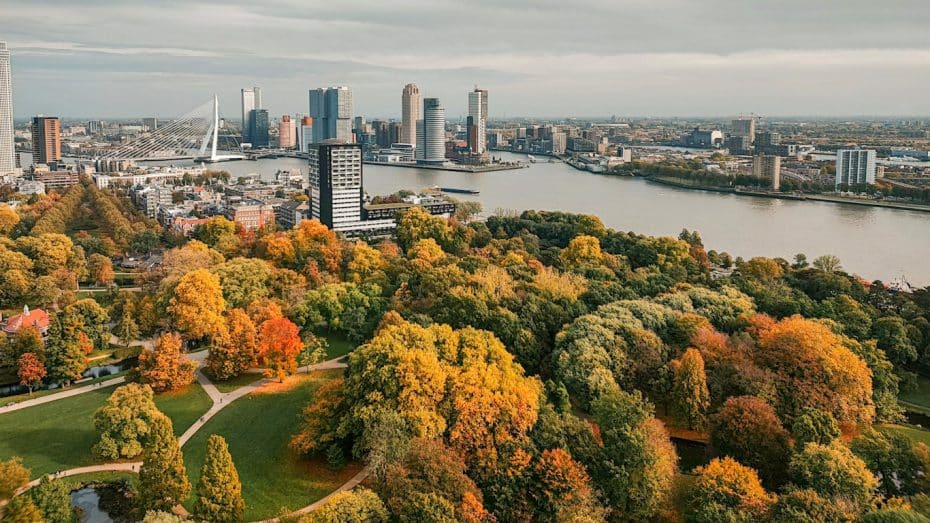
Het Park is another place worth visiting during a two-day trip to Rotterdam. Founded in the 1850s, the famous landscape architect Zocher designed the park, modeling it after English-style gardens. This park is adjacent to the Euromast, west of Rotterdam’s city center.
Het Park creates a peaceful escape to admire various trees, plants, and birds. The park also stands out for its collection of old trees and winding paths, ideal for a stroll through a stretch of nature that contrasts with the city’s modern architecture.
Inside the park, you explore monuments such as the Norwegian seaman’s church and a statue of the famous poet Hendrik Tollens. Another highlight is De Heuvel (The Hill), designed by architect Gerrit de Jongh in 1886 as an artificial mountain from which you can enjoy beautiful views.
Het Park is accessible by metro, tram, or bus. Stops are close at Euromast/Erasmus MC, which serves tram lines 8 and 23, and at Kykuit, which serves buses 44. The nearest metro station is Dijkzigt.
11. Lijnbaan and Koopgoot streets
Koopgoot and Lijnbaan are two major shopping areas in Rotterdam. Lijnbaan was the first pedestrian shopping street in Europe after World War II. The designers behind this street were architects Van den Broek and Bakema during the reconstruction era of Rotterdam.
The Koopgoot, whose official name is Beurstraverse, is an underground shopping street that intersects with Lijnbaan. It was created in the 1990s as an innovative solution connecting two shopping areas, allowing pedestrians to avoid traffic above ground.
Lijnbaan and Koopgoot are in the city center of Rotterdam. They are accessible via public transportation, with numerous tram and metro stops nearby, such as Beurs station for the Koopgoot. You can explore many shops and boutiques that offer clothing, electronics, home goods, and more.
The exact location of Lijnbaan is between Weena and Coolsingel streets, while the Koopgoot runs underneath Coolsingel Street. These areas are famous for their contributions to post-war urban development and for representing Rotterdam’s modern architectural identity.
12. Erasmus Bridge
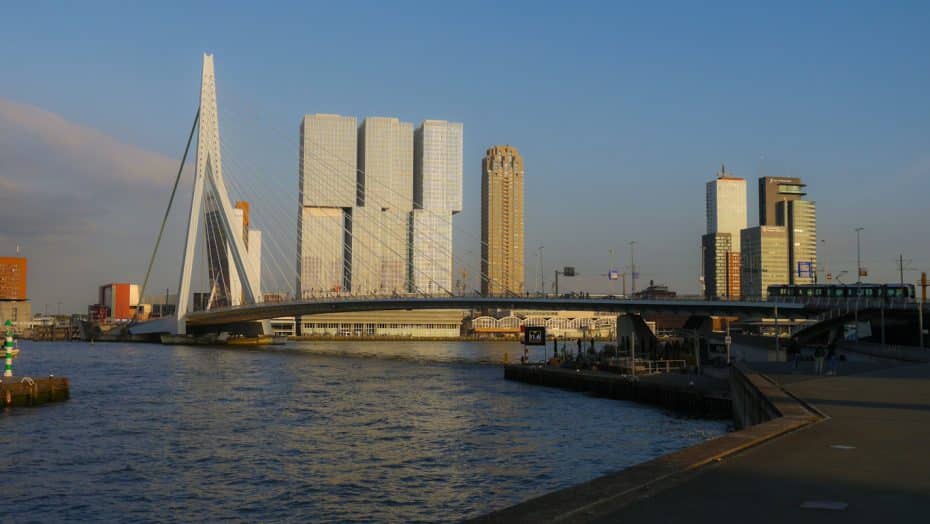
The Erasmus Bridge is an essential structure in Rotterdam. Finished in 1996 and designed by Ben van Berkel, the bridge connects the north and south parts of the city over the New Meuse River.
The bridge has a unique asymmetrical design with a single white tower, earning it the nickname “The Swan.” It stretches 802 meters in length with a main span of 284 meters. Besides its functionality, the Erasmus Bridge has architectural significance, contributing to Rotterdam’s skyline.
Located near the center of Rotterdam, you can reach the Erasmus Bridge via public transport, bicycle, or walking. Nearby attractions include the Kunsthal art museum and the Maritime Museum Rotterdam.
This bridge is lovely during sunset, so it is the perfect way to end 48 hours in Rotterdam.



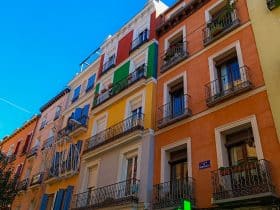
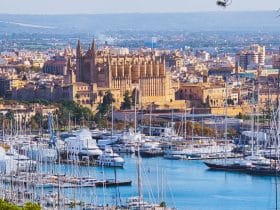
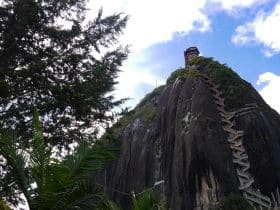
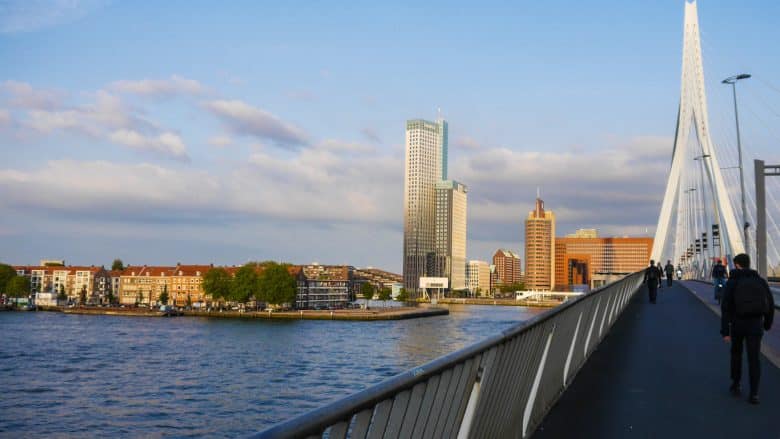
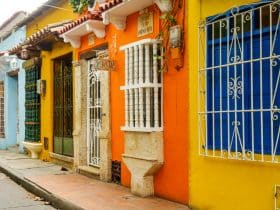

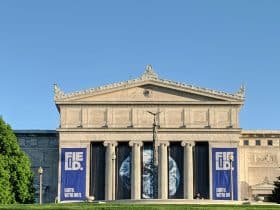








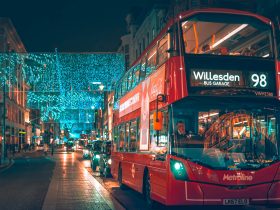



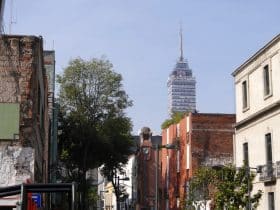
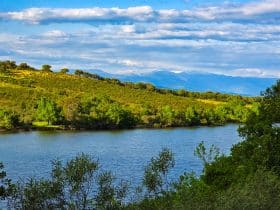
Leave a Reply
View Comments